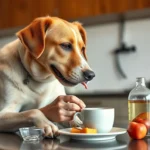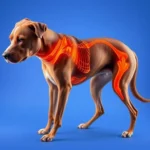
It’s not uncommon for pet owners to find themselves in a bit of a panic after their furry friends have gotten into something they shouldn’t have. A frequent concern is “my dog ate grease.” Whether it’s from a kitchen spill or leftovers, understanding how grease affects dogs is crucial for every pet owner. Let’s dive into the details to ensure you’re well-informed.
Understanding Grease and Its Sources
What is Grease?
Grease is essentially a type of fat that is often left behind after cooking certain foods. In the context of food, it can come from animal fats, cooking oils, and other culinary sources. This substance can be slippery and difficult to clean up, making it an enticing target for curious dogs.
Common Sources of Grease
Dogs often encounter grease in various ways within the home. Some common scenarios include:
- Kitchen accidents: Spills from cooking or food preparation can easily attract a dog’s attention.
- Human food preparation: When frying or roasting meats, excess grease can drip and pool, creating a hazard.
- Fast food and takeout items: Leftover greasy wrappers or containers can be irresistible for dogs scavenging for food.
Immediate Reactions After Ingestion
Signs and Symptoms to Watch For
If you discover that your dog ate grease, it’s essential to monitor them closely for signs of distress. Common symptoms include:
- Vomiting: This is often the body’s immediate reaction to expel something harmful.
- Diarrhea: The digestive system may react negatively, leading to loose stools.
- Lethargy: If your dog seems unusually tired or inactive, it could indicate an issue.
- Abdominal pain: Watch for signs of discomfort, such as whining or a hunched posture.
When to Contact a Veterinarian
Not all cases require a trip to the vet, but knowing when to seek help is crucial. Contact your veterinarian if your dog exhibits:
- Severe vomiting or diarrhea
- Signs of dehydration (like excessive panting or dry gums)
- Persistent lethargy
- Abdominal swelling or sensitivity
Prompt action can make a significant difference, especially in severe cases.
Potential Health Risks of Grease Ingestion
Gastrointestinal Issues
Ingesting grease can lead to significant gastrointestinal upset. Dogs may experience a range of symptoms, from mild to severe. One of the most concerning conditions that can arise is pancreatitis, an inflammation of the pancreas that can be triggered by a high-fat diet. Symptoms of pancreatitis include:
- Vomiting
- Diarrhea
- Abdominal pain
- Loss of appetite
Long-term Health Concerns
The risks associated with grease ingestion don’t stop at immediate symptoms. Over time, consuming greasy substances can lead to:
- Obesity: High-fat diets can contribute to excessive weight gain.
- Diabetes: Obesity increases the risk of diabetes, a serious condition requiring lifelong management.
- Liver and kidney health: Excess grease can strain these vital organs, leading to potential long-term health issues.
What to Do If Your Dog Eats Grease
Initial Steps to Take
If you discover that your dog ate grease, the first step is to assess the situation. Consider the following:
- Amount ingested: A small lick may warrant less concern than a large quantity.
- Type of grease: Animal fats can be more harmful than vegetable oils.
Home Remedies and Treatments
If your dog ingested a small amount of grease without severe symptoms, you might consider:
- Safe ways to induce vomiting: Consult your veterinarian before attempting this. They may advise using hydrogen peroxide in specific circumstances.
- Dietary adjustments: A bland diet of boiled chicken and rice can help soothe an upset stomach.
Recommended Veterinary Treatments
In cases where symptoms are severe or prolonged, a veterinarian may recommend treatments, including:
- Fluids: To combat dehydration.
- Medications: To control vomiting or diarrhea.
- Dietary changes: To help manage any long-term issues that may arise.
Follow-up care is essential to ensure your dog recovers fully.
Preventing Future Incidents
Safe Food Storage Practices
To reduce the risk of your dog getting into grease, consider these storage tips:
- Keep food out of reach: Store all greasy items on high shelves or in cabinets.
- Proper disposal of greasy food items: Ensure that leftovers and food waste are secured in dog-proof containers.
Training Your Dog
Training can significantly help in preventing scavenging behaviors:
- Basic obedience commands: Teach commands like “leave it” or “drop it” to discourage your dog from eating undesirable items.
- Behavioral training techniques: Positive reinforcement can be effective in training your dog to avoid temptations.
Creating a Dog-Friendly Kitchen
Making your kitchen a safer environment for your dog includes:
- Tips for pet-proofing your kitchen: Use child-proof locks on cabinets and secure trash cans.
- Using barriers and gates: These can help restrict access to areas where food is prepared or stored.
FAQs About Dogs and Grease
Can dogs eat any type of grease?
Not all grease is created equal. While some small amounts of certain vegetable oils may not cause immediate harm, animal fats (like bacon grease) can be more detrimental to your dog’s health. Always err on the side of caution.
What if my dog only ate a small amount of grease?
If your dog ingested a small amount, monitor them closely for any symptoms. If they develop vomiting, diarrhea, or other concerning signs, it’s best to consult a veterinarian.
Can grease cause long-term issues even with small amounts?
Yes, even small amounts of grease can contribute to cumulative health issues over time, particularly if ingested regularly. It’s vital to maintain a balanced diet for your dog and avoid high-fat foods whenever possible.
Conclusion
Understanding the implications of my dog ate grease is essential for responsible pet ownership. By recognizing the signs of distress, knowing when to seek veterinary help, and implementing preventative measures, you can protect your furry friend from potential harm. Always remember, when in doubt, consult your veterinarian for tailored advice and care. Your vigilance and proactive approach can make all the difference in your dog’s health and well-being.









